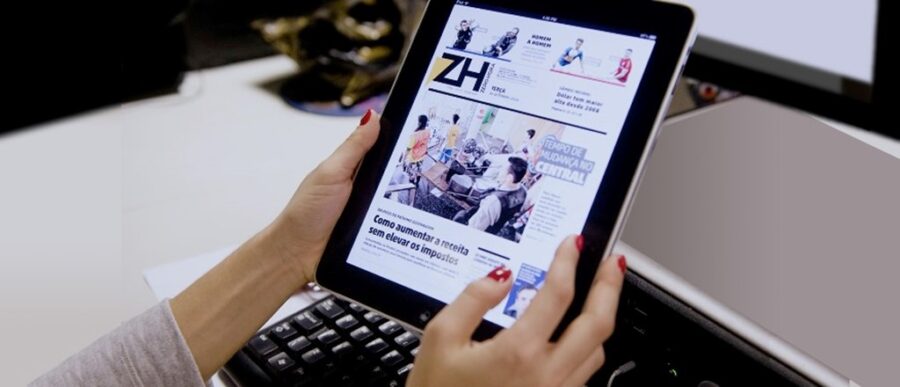How does a traditional media company stay relevant in the digital age? For Grupo RBS, a Brazilian media conglomerate that owns newspapers, and radio and TV stations, the answer was to embrace the change and look for opportunities to thrive. Tulio Milman, a journalist at Grupo RBS, explains exactly how the 60-year-old company learned to pivot, in this opinion piece.
Stop investing in the poison that kills you. This phrase prompted a change of direction that turned Grupo RBS — a Brazilian conglomerate with $1 billion in annual revenues — into a role model for South American media companies. The poison is the technology applied to distribution platforms. This doesn’t mean you should let go of innovation or pretend that the communication industry hasn’t changed radically. The truth is the other way around.
Based in the southern state of Rio Grande do Sul, RBS was founded when Maurício Sirotsky Sobrinho, a Brazilian of Jewish descent (his parents emigrated from Eastern Europe), affixed a loudspeaker to a light pole in a square. Over the last 60 years, RBS has grown to become one of the top media groups in Brazil. The company controls three newspapers, five radio stations and 12 TV stations that generate local content. It also broadcasts Globo TV content in the southern part of the country. RBS also operates increasingly over digital platforms. Its Zero Hora newspaper ranks first in Brazil in terms of social media engagement, with 23.3 million online visits each month.
Just like most global media companies, RBS was forced to go through a learning curve in the digital age. Eduardo Sirotsky Melzer, 45, president of RBS and grandson of the founder, recalls how experience taught his company to deal with digital disruption. “It’s useless to fight against the market,” he says. First, he had to face the brutal facts. In the 1990s, the traditional media market was growing at 20% a year in Brazil — but those days are gone. “It’s over now and won’t be around again in the near future,” says Melzer. The nation’s printed newspaper industry, for instance, saw its share of media advertising spending plunge from 28% in 1995 to 16% in 2005, though RBS did not lose its audience.
As a result, RBS leaders had to make tough calls, which ultimately led to increased efficiency in operations and sales. Forced to confront reality, they instead focused on the question, “Where are the opportunities?” They found that even within the turmoil of the media industry, opportunities did exist. The decline in advertisement sales led to a shift of direction: local journalism put all its eggs in the digital subscription basket for sustainability. Paper and radio were formerly at the forefront of this industry with business models based on advertising. But in a global competitive landscape, the distribution model has shifted to digital platforms, where paid content has proven to be the only sustainable solution for the future.
“Paid content has proven to be the only sustainable solution for the future.”
Zero Hora newspaper, in an effort to get readers to shift from print to digital, introduced a breakthrough tablet subscription in 2015 for a Samsung device that allowed consumers to access a modern e-paper with two daily editions. It was a successful initiative among print readers who highly value curatorship. In the pre-sales period, 5,000 readers were ready to buy it. However, the advertising campaign had to be interrupted right after the digital subscription was introduced due to product shortage.
Belief in shifting to digital subscriptions has reached such a proportion that prices in the print paper industry spiked 20%. The shift from print to digital subscriptions has been working. Digital circulation has been growing 58% year-on-year. “We are building a portfolio of digital products that takes into account the level of digital adoption and the need for curatorship — that means we have products for digital natives that are built in that way and we have others trying as much as possible to simulate the experience of print reading,” says Andiara Petterle, senior vice president of product and operations at RBS.
Recently, the group has consolidated the commercial operations of all media properties. In the past, all business units vied for advertisements, each of them coming up with independent sales pitches. Such a strategy worked well in a growing and lucrative market. Today, radio and TV stations, newspapers and digital operations offer consolidated solutions with an integrated focus on individual needs of clients.
Besides requiring a change in business models, the new reality of the digital transformation brought along some benefits as well. One of them was the strengthening of free and independent journalism, increasingly detached from the commercial interests of major advertisers.
The Way Forward
Stuart Diamond, Wharton professor, former Pulitzer prize-winning journalist and author of Getting More, believes that there is only one way for traditional media companies to survive and thrive in this new business environment: to invest in high-quality content. He disagrees with those who predict that traditional media won’t be able to evolve and stay relevant: “It does not have to do with where you came from, but with the development of your current vision.”
In this new scenario, what was a scale disadvantage has turned into a competitive advantage. Only local media can cover on a daily basis what happens in the realms of culture, economics, street traffic and local soccer clubs. Game scores are now a commodity; what really attracts the audience is what happens in the locker rooms, the players’ feelings, tactical analysis and projections.
Nelson Mattos, an independent consultant in Silicon Valley, agrees. He was previously Google’s vice president for product and engineering for Europe and emerging markets, and IBM’s vice president for information and user technologies. “Facebook and Google have not been successful so far in engaging with relevant local content. That’s their main challenge in the near future.”
Mattos, a board member of Hands, an RBS-owned company specializing in mobile advertising, believes that digital transformation has matured for media firms. “It’s common sense that digital transformation is gaining speed in almost every aspect of our lives, from health to education, but it will slow down in the media industry for a simple reason: It was the first to be deeply affected.”
Diamond divides the digital tsunami into three waves: transformational, disruptive and even unnecessary, because “sometimes it takes more time for a waiter to punch an order [into a device] than to remember it or to write it in a note.” These digital waves hit the industry hard. Melzer recalls how they impacted RBS. “Our reaction was to invest immediately in the same areas where Google and Facebook were growing. However, these companies have global scale. It was a lost battle. The challenge was to leave the battle behind with a minimum of losses and take advantage of the lessons we had learned.”
“That is our answer to the market: We follow in the direction it has shown us, not the other way around.”
RBS decided to sell its local guides and online classified advertisement operations. “These are joint processes nowadays associated to a logical rationale that bear no relationship to regional companies,” Melzer says. “After a few million dollars invested and not many tangible results, it was time to learn a lesson: Instead of making an impossible bet, we should focus on skills. We were actually going back to company basics with the firm belief that we were not going through a technological revolution. It was rather a social revolution. People wanted to be heard ─ that’s the real inspiration and the driving force behind all those changes.”
Over 60 years of history, RBS had accumulated enough expertise in managing operations, logistics and brand building, in addition to developing a good brand and consolidating wide networking in several areas of the country. For it to thrive again, the company must use its expertise in new and profitable areas. In this context, RBS founded e.Bricks and focused on building digital native companies. One successful example is Wine.com, by far the largest wine distributor in Latin America that offers online purchases and subscriptions. In 2014, the company had gains of US$ 18 million. The forecast for this year is US$ 151 million.
An Odd Mix?
Do wine and media mix? Why not? RBS’s expertise includes brand building, curatorship, managing and, above all, accumulated logistical know-how thanks to daily distribution of 200,000 newspapers in a geographical area more than twice as large as Pennsylvania.
Today, RBS Media and e.Bricks may appear to be worlds apart — but in fact, they are not. The first has its headquarters in Porto Alegre, a city in the south of Brazil; the second, in São Paulo, Latin America’s economic powerhouse. Despite their geographical distance of 749 miles, both companies are focused on the same skills and values. Those skills led e.Bricks to another level. Today, the company is divided into two areas: EB Capital — focused on investments and the middle market, and e.Bricks Ventures — which invests in early stage startups.
At the same time, our belief in journalism goes on unshaken. A month ago, we launched a new product: digital consolidation of newspaper and radio platforms, which now operates based on the same product online, while keeping each one’s traditional distribution format — paper and live radio. That is our answer to the market: We follow in the direction it has shown us, not the other way around.
RBS realized it was time to go back to basics. Except that square one is digital, a hub for information, exchange of ideas and transformation for the 12 million people in Rio Grande do Sul, RBS’s headquarters. “It was time to leave traditional business routine and introduce a process of confidence and horizontal contact with the community,” says Melzer.
In this sort of digital gold rush, one thing is for sure: Change is the only option. Former GE CEO Jack Welch once said that when the external change is faster than the internal change, the end is near. Believe it or vanish.



